ISSN ONLINE(2319-8753)PRINT(2347-6710)
ISSN ONLINE(2319-8753)PRINT(2347-6710)
Tasneembano Kazi1 , Arjun Virupakshi2
|
| Related article at Pubmed, Scholar Google |
Visit for more related articles at International Journal of Innovative Research in Science, Engineering and Technology
Tanning industry is one of the oldest industry which is highly complex and is characterized by high BOD, COD, suspended solids, settleable solids, sulphide, chloride and chromium. Untreated tannery effluents when discharged directly into the water bodies or into the open lands cause irreversible damage to the environment. Coagulation–flocculation is one of the most important physicochemical treatment steps employed in industrial wastewater treatment to reduce the suspended and colloidal materials responsible for turbidity of the wastewater. During the last decade, more interest has been given on the use of natural coagulants in treating industrial wastewater. Natural coagulants are, in general, used as point-of-use technology in less-developed communities, since they are relatively cost-effective compared to chemical coagulants. Also they can be easily processed in usable form and biodegradable Cicer arietinum, Moringa oleifera, and Cactus were used as locally available natural coagulants in this study to reduce turbidity and COD of tannery wastewater. The tests were carried out, using tannery wastewater with conventional jar test apparatus. Optimum dosage and optimum pH were determined. The optimum dosage of Cicer arietinum, Moringa oleifera, and Cactus were found as 0.1,0.3 and 0.2gm/500ml respectively. The optimum pH value with Cicer arietinum, Moringa oleifera, and Cactus was found to be 5.5, 4.5 and 5.5, respectively. In case of Cicer arietinum, Moringa oleifera, and Cactus maximum reduction in turbidity were found to be 81.20%, 82.02% and 78.54%, and maximum reduction in COD were found to be 90%, 83.33% and 75%, respectively. Among the natural coagulants used in this study maximum turbidity reduction of 82.02% and COD reduction of 90% was found with Moringa oleifera and Cicer aretinum, respectively.
Keywords |
| Cicer aretinum, Moringa oleifera, Cactus , Turbidity, Chemical oxygen demand (COD). |
INTRODUCTION |
| Ever increasing industrialization and rapid urbanization have considerably increased the rate of water pollution. The dwindling supplies of natural resources of water have made this a serious constraint for industrial growth and for a reasonable standard of urban living [1]. Tanning Industry is one of industries, which is considered as highly polluting industry [2]. Tanneries generate wastewater in the range of 30 - 35 L/kg skin or hide processed with variable pH and high concentrations of suspended solids, BOD, COD. Major problems are due to wastewater containing heavy metals, toxic chemicals, chloride, lime with high dissolved and suspended salts and other pollutants [3]. Due to the inherent characteristics of tannery effluents, various physico-chemical techniques have been studied for the applicability to the treatment of tannery wastewater [4]. Coagulation is the most essential process in the treatment of both turbid surface and industrial wastewaters. Coagulation–flocculation is one of the most important physicochemical treatment steps in industrial wastewater treatment to reduce the suspendedand colloidal materials responsible for turbidity of the wastewater and also for there reduction of organic matters which contributes tothe BOD and COD content of the wastewater [1].Due to the lack of proper water treatment systems in these rural or underdeveloped communities, the best immediate option is to use simple and relatively cost effective point-of-use (POU) technologies such as coagulation [5]. Its application includes removal ofdissolved chemical species and turbidity from water via addition of conventional chemical-based coagulants, namely, alum (AlCl3), ferric chloride(FeCl3) and poly aluminium chloride (PAC).While the effectiveness of these chemicals as coagulants is well-recognized, there are, nonetheless, disadvantages associated with usage of these coagulants such as ineffectiveness in low-temperature water, relatively high procurement costs, detrimental effects on human health, production of large sludge volumes and the fact that they significantly affect pH of treated water. There is also strong evidence linking aluminium-based coagulants to the development of Alzheimer’s disease in human beings. It is therefore desirable to replace these chemical coagulants withplant-based coagulants to counteract the afore mentioned drawbacks [5]. |
MATERIALS AND METHODOLOGY |
| In this study Cicer arietinum(Chickpea), Moringa oleifera(Drumstick seeds), and Cactus were used as natural coagulants . Cicer arietinum(Chickpea) ,Moringa oleifera were obtained from local market of Belgaum city and cactus is collected from road side which is proved to be species Opuntia ficus indica. |
 |
A. Preparation of Natural Coagulants |
| Cicer aretinum seeds were removed from the hulls and the seeds were ground to fine powder and sieved to get particles of the size 600 μm [6]. Moringa oleifera seeds were removed from the pods, kept for sun dry, and external shells were removed. Mature seeds showing no signs of discoloration, softening, or extreme desiccation were used. The seed kernels were ground to fine powder and sieved to get particles of the size 600 μm [7]. Dry Opuntia powder was prepared by cutting fresh opuntia species into strips of 1cm width and followed by drying at 60°C for 24 hours. Dry Opuntia species was ground in a grinder and sieved to get particles of the size 600 μm [8]. |
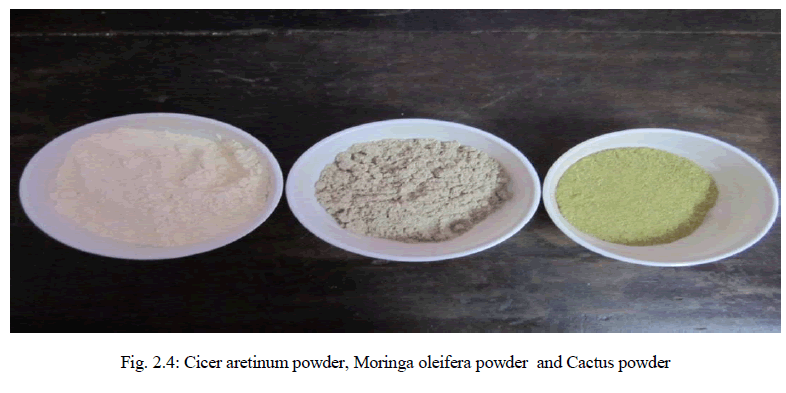 |
B. Coagulation Studies |
| Jar test is the most widely used experimental methods for coagulation-flocculation. A conventional jar test apparatus was used in the experimentsto coagulate sample of Tannery waste water using natural coagulants. |
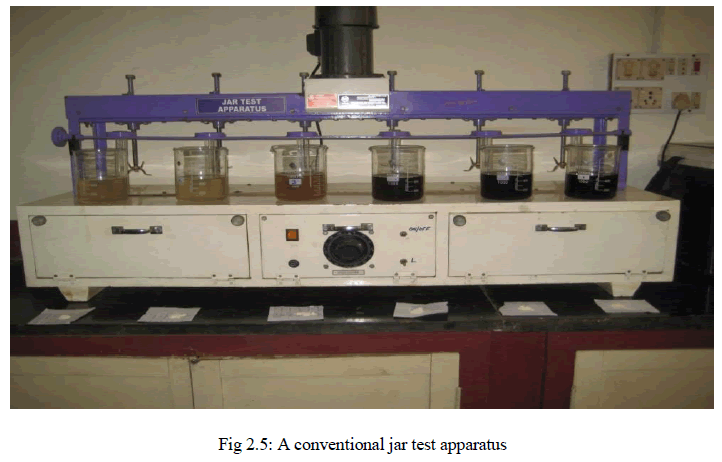 |
| It was carried out as a batch test, accommodating a series of six beakers together of 1 litre capacity with six spindle steel paddles. Before operating the jar test, the sample was mixed homogenously. |
| This study consists of batch experiments involving rapid mixing, slow mixing and sedimentation. The apparatus consists of six beakers to be agitated simultaneously. 500 ml of the Tannery wastewater samples was put in to each 6 one-liter beakers and placed under jar test apparatus. The required dose of previously prepared powder of Cicer aretinum, Moringa oleifera and Cactus i.e., 0.05, 0.1, 0.2, 0.3, 0.4, 0.5 gm/500ml was added simultaneously. The paddles were inserted in the jars, the apparatus was switched on and the whole procedures in the jar test were conducted in different rotating speed, which consist of rapid mixing (100 rotation per minute, rpm) for 1 minute and slow mixing (30rpm) for 10 minutes. After the agitation being stopped, the suspensions were allowed to settle for 20 minutes [8]. Finally, a sample was withdrawn using a pipette from the middle of supernatant for physicochemical measurements, so that the effect of coagulant dose on coagulation could be studied.Then, the samples ought to be measured for turbidity, COD for representing an initial concentration. |
C. Optimization of Coagulant Dosage and pH |
| The optimum dosage and pH of the natural coagulants can be evaluated by using jar test apparatus. The pH of original Tannery wastewater was 5.5. The study was conducted to evaluate optimum dosage by varying the dosage as 0.05, 0.1, 0.2, 0.3, 0.4, 0.5 gm/500ml at original pH of tannery wastewater i.e 5.5. Using the optimum dosage optimum pH for different coagulants is determined. The optimum pH is determined for each coagulant by varying the pH of Tannery wastewater as 3.5, 4.5, 5.5, 6.5, 7.5 and 8.5 at optimum dosages of 0.1, 0.3, and 0.2gm/500ml of Cicer aretinum, Moringa oleifera and Cactus respectively. |
RESULTS AND DISCUSSIONS |
| The optimum dosage and optimum pH of Tannery wastewater for NC1 and NC2 and NC3 are shown in the Figure 3.1 and Figure 3.2. |
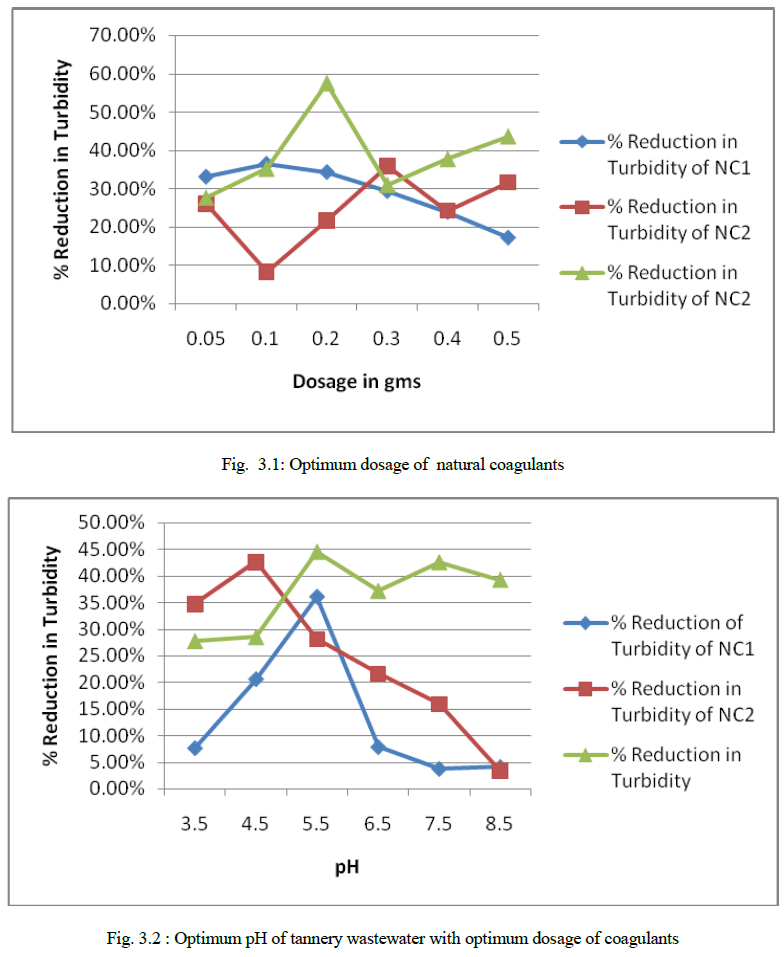 |
A. TREATMENT OF TANNERY WASTEWATER WITH NATURAL COAGULANTS |
| 1) Treatment of Tannery Wastewater using Cicer aretinum (NC1) |
| The effluent from tannery wastewater was treated with Cicer aretinum seed powder with optimum dosage of 0.1gm/500ml at optimum pH=5.5 for the reduction of turbidity and COD. Variation in the COD at every 2,000mg/l concentration is carried out. The results obtained after the analysis are represented in Fig. 3.3 and 3.4 respectively for Turbidity and COD. |
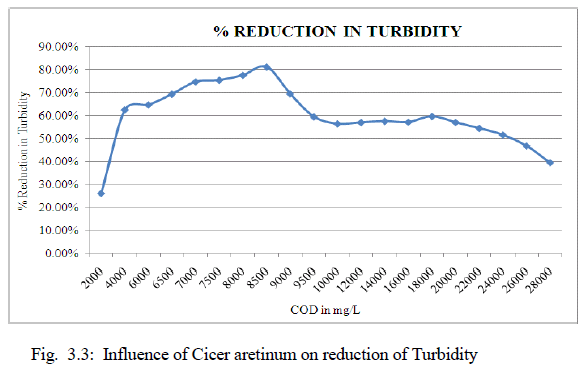 |
| Initially, the COD concentration is varied at the rate of 2,000mg/L. The maximum reduction in turbidity is found at 8,000mg/L of 77.95%. Further, the experiments were carried out between 6,000mg/L to 10,000mg/L at every 500mg/L of COD concentration. Then the maximum reduction in turbidity obtained is 81.20% at 8,500mg/L of COD concentration. Asrafuzzaman et al.[11] studied the reduction efficiencies of Moringa oleifera, Dolichos lablab, Cicer aretinum in treatment of synthetic water and reported that Cicer aretinum is most effective in reduction of turbidity up to 95.89%. |
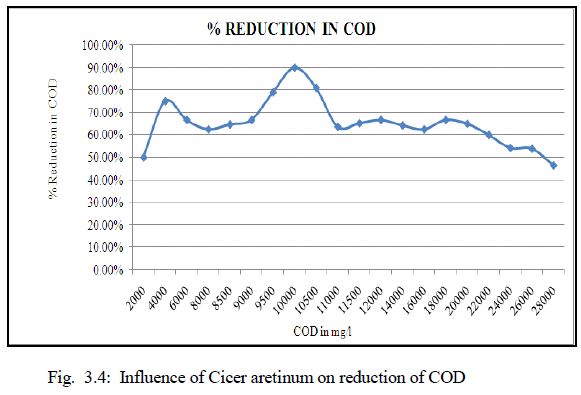 |
| Initially, the COD concentration is varied at the rate of 2,000mg/L. The maximum reduction in turbidity is found at 8,000mg/L of 77.95% . Further, the experiments were carried out between 6,000mg/L to 10,000mg/L at every 500mg/L of COD concentration. Then the maximum reduction in turbidity obtained is 81.20% at 8,500mg/L of COD concentration. Asrafuzzaman et al.[6] studied the reduction efficiencies of Moringa oleifera, Dolichos lablab, Cicer aretinum in treatment of synthetic water and reported that Cicer aretinum is most effective in reduction of turbidity up to 95.89%. |
| 2) Treatment of Tannery Wastewater using Moringa oleifera |
| The effluent from tannery wastewater was treated with Moringa oleifera seed powder for the reduction of Turbidity and COD. Variation in the COD at every 2,000 mg/l is carried out with optimum dosage 0.3gm/500ml of Moringa oleifera and pH 4.5. The results obtained after the analysis are presented in Fig 3.5, 3.6, respectively, for turbidity and COD. |
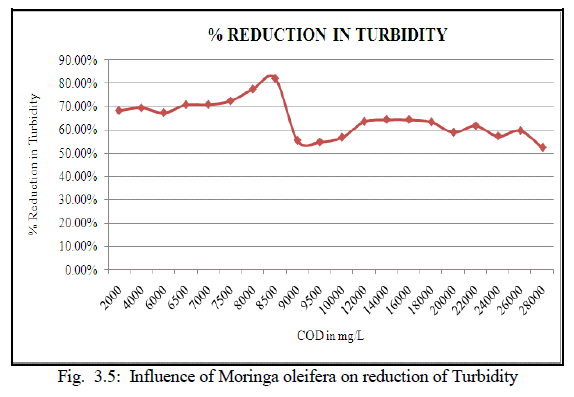 |
| Initially, the COD concentration is varied at the rate of 2,000mg/L. The maximum reduction in turbidity is found at 8,000mg/L of 77.38% . Further, the experiments were carried out between 6,000mg/L to 10,000mg/L at every 500mg/L of COD concentration. Then the maximum reduction in turbidity obtained is 82.02% at 8,500mg/L of COD concentration. |
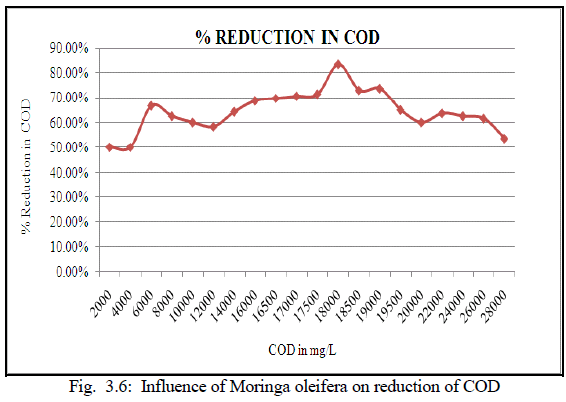 |
| Initially, the COD concentration is varied at the rate of 2,000mg/L. The maximum reduction in COD is found at 18,000mg/L of 83.33% . Further, the experiments were carried out between 16,000mg/L to 20,000mg/L at every 500mg/L of COD concentration. But the maximum reduction in COD remains the same (83.33%). Veeramalini et al.[9] reported that 500mg/l Moringa oleifera reduces COD by 37% in treatment of textile wastewater. |
| 3) Treatment of Tannery Wastewater using Cactus |
| The effluent from tannery wastewater was treated with Cactus powder for the reduction of Turbidity and COD. Variation in the COD at every 2000mg/l concentration is carried out with optimum dosage 0.2gm/500ml of Cactus at pH 5.5. The results obtained after the analysis are represented in Fig. 3.7 and 3.8 respectively for Turbidity and COD. |
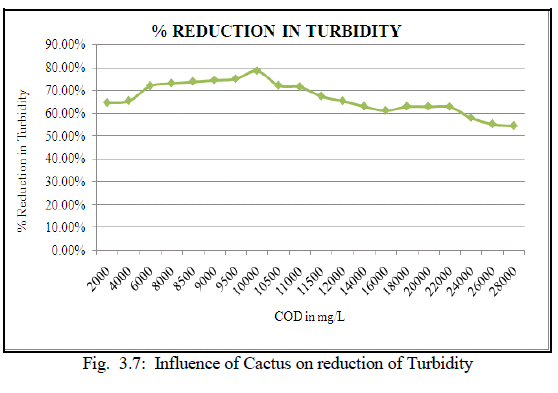 |
| Initially, the COD concentration is varied at the rate of 2,000mg/L. The maximum reduction in turbidity is found at 10,000mg/L of 78.54%. Further, the experiments were carried out between 8,000mg/L to 12,000mg/L at every 500mg/L of COD concentration. But the maximum reduction in turbidity remains the same (78.54%). Similar results were also reported by Yang et al. [10]. They reported, a maximum reduction in turbidity was found to be 98% and 70% for estuarine and river water respectively, and also Shilpa et al.[11] reported a maximum turbidity removal efficiency of 89.03% was found for lake water when treated with Cactus. |
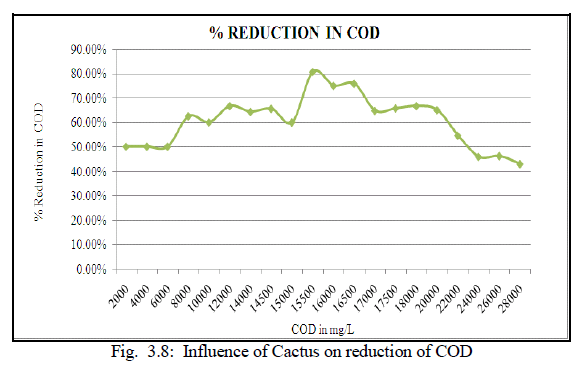 |
| Initially, the COD concentration is varied at the rate of 2,000mg/L. The maximum reduction in COD is found at 16,000mg/L of 75.00%. Further, the experiments were carried out between 14,000mg/L to 18,000mg/L at every 500mg/L of COD concentration. Then the maximum reduction in COD obtained is 80.65% at 15,500mg/L of COD concentration. |
| B. Comparison of Efficiency of Natural Coagulants |
 |
| Table 3.1 presents comparative results of three natural coagulants; Cicer aretinum, Moringa oleifera and Cactus in the reduction of turbidity and COD with their optimum dosage at optimum pH value. From the table 3.1, it is clear that, out of three coagulants Cicer aretinum is more efficient in reduction of COD of 90.00%. On the other hand, Moringa oleifera gave highest turbidity reduction of 82.02%. |
CONCLUSIONS |
| The following conclusions are drawn from the experimental study conducted on treatment of tannery wastewater using natural coagulants: |
| 1) Tannery wastewater has the characteristics ; pH-5.5, Color-Dark brown, COD- 28,000 mg/l, BOD-8,000mg/l, Total solids-15,200mg/l, Dissolved solids-6,650 mg/l, Suspended solids8,550mg/l, Turbidity-66 to 960 and all the parameters are more than the permissible limit. |
| 2) The optimum dosage of Cicer aretinum, Moringa oleifera and Cactus seed powder as coagulant is found to be and 0.1gm/500ml, 0.3gm/500ml and 0.2gm/500ml. |
| 3) The optimum pH in coagulation process for Cicer aretinum, Moringa oleifera and Cactus seed powder at optimum dosage is found to be 5.5, 4.5 and 5.5,respectively. |
| 4) Increasing dosage of Moringa oleifera lead to decrease in turbidity upto the optimum dosage after which the residual turbidity increases due to floc restabilization. |
| 5) Among the three natural coagulants used in the study, maximum turbidity reduction is found to be 82.02% with Moringa oleifera. |
| 6) Among the three natural coagulants used in the study, maximum COD reduction is found to be 90.00% with Cicer aretinum. |
| 7) As it is observed that Cactus opuntia is consistant in turbidity reduction of almost above 60.00% for all COD concentrations. Hence it is concluded that cactus opuntia has the potential to be utilized for tannery wastewater treatment. |
| 8) Among the three natural coagulants used in the study, Cicer aretinum has the COD reduction of 90.00% and turbidity reduction of 81.20%.Hence it is concluded that as compare to other two coagulants Cicer aretinum is the effective coagulant in treating tannery wastewater. |
References |
|